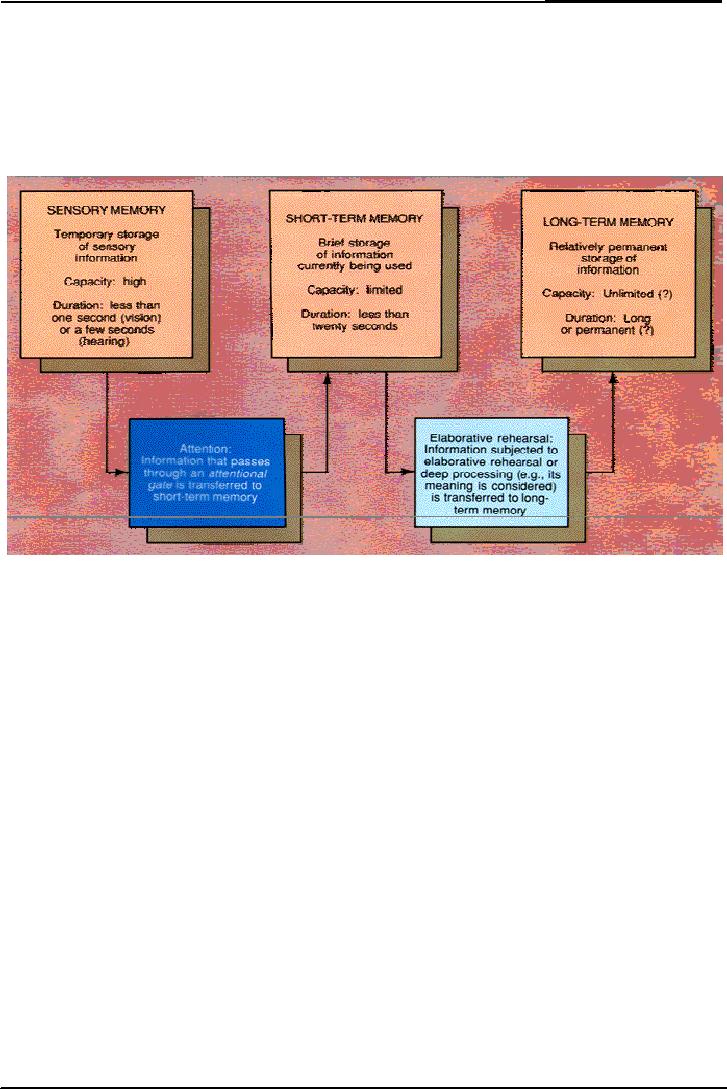 |

Cognitive
Psychology PSY 504
VU
Lesson
27
MEMORY
This
following model is showing
the whole process of memory.
First of all there is
sensory
memory.
Information from environment
comes in sensory memory then
those information
receive
attention
goes to short term memory.
After elaborative rehearsal
the information transfers
short
term
memory to the long term
memory. The descriptions of
all these memories are
given in the
figure.
THE
NATURE OF FORGETTING
Decay
Theory - forgetting
occurs due to passage of
time.
Interference
Theory - memory
for other things or
performance of another task
interferes with
memory.
Two types of interferences
are given below;
Retroactive
interference: later
occurring information interferes
with earlier
information.
Proactive
interference: earlier
occurring information interferes
with later
information.
Keppel
& Underwood:
Items
on trials 1-3 are similar
and on trial 4 they may be
similar or may be different.
When items
are
similar they interfere with
one another; when they
are different they are
more readily
recalled.
This
is called proactive
interference.
Release
from PI
Wickens,
Born & Allen (1963)
conducted an experiment to show
the proactive interference.
They
showed
3 numbers or 3 words. They
showed words or numbers for
20 second interval
(another
task).
In
experimental group, after
number they showed words.
And after words they
showed
numbers.
The performance of that
group was
85%,40%,30%,84%
In
control Group, they showed
words after words and
numbers after numbers.
The
performance
was 85%, 40%, 30%,
25%.
Release
from PI
Another
experiment was conducted by
Gunter, Clifford & Berry
(1980). In that experiment
three
items
in TV news were presented.
One group was shown
sports news and other
group was
80

Cognitive
Psychology PSY 504
VU
shown
political news. In experiment
first of all three political
items were presented to the
political
news
group and then they
were shown a sports news
item. In other condition
three sports items
were
shown to the sports group
and then they were
presented a political news
items.
The
results of that experiment
was
Control
Group performance in four
trials: 87%, 67%, 55%,
43%
Experimental
Group performance in four
trials : 82%, 67%, 55%,
74%
Implications
The
implications of these experiments
are
Interference
can be reduced by studying
different things at the same
time.
Similar
things might interfere with
each other.
But
this is not to be confused
with studying which requires
similar things to be
grouped
together
for better recall.
STM
strategies
It
is OK to study similar things
together.
When
you feel these are
interfering with further
learning, switch to something
else.
STM
& Working Memory
A
different point of view is
whether the STM and working
memory are same or
different.
Klapp,
Marshburn & Lester (1983)
said Working Memory is
different from STM?
A
model proposed by Engle,
Kane & Tuholski (1998)
suggests not Short Term
Memory
necessarily
different from the working
memory but it is a part of
working memory.
Working
Memory
Engle's
Model:
1.
Central Executive
(Working
memory capacity, controlled
attention) attention is a part of
working memory. The
task
of
central executive is to achieve
activation through controlled
retrieval.
Another
task of central executive is to
maintain activation.
Another
function of central executive is to
block interference through
inhibition of distractors.
2.
Short Term Memory
Central
executive moves toward STM.
In short term memory traces
become active above
threshold,
with loss due to decay or
interference.
Some
traces receive further
activation by becoming the
focus of attention. Trace
consists of a
pointer
to a region of Long Term
Memory. Trace is not a part
of long term memory from
short
term
memory. Trace is a pattern
and it ahs a indicator of
information.
3.
Grouping Skills, coding
strategies and procedures
for maintaining
activation
Information
could be phonological, visual,
spatial, motoric, auditory,
etc.
Grouping
skills, strategies, and
procedures for maintaining
activation are more or less
attention
demanding
on the task and the
subject.
The
important thing of this
model is it gives a prominent
role to the central
executive. It is a
decision
making personality.
In
Engle's model the prominent
Role was also given to
Central Executive.
81

Cognitive
Psychology PSY 504
VU
The
Central Executive manages
controlled attention capacity
model of attention and
allocation
of
attention in working memory
can be explored.
Another
important thing in this
model is STM maintains activated
memory traces. Like
Phonological
loop, scratchpad, touch
short term memory
etc.
A
model of Consciousness
Another
perspective of short term
working memory is that it is
also related to the
consciousness.
Working
memory is a way of looking
toward the consciousness.
Working Memory should
rekindle
discussion
of consciousness.
STM
determines the limits of the
present. The Psychological
Time of short term memory is
from 1
second
to 20 seconds. The stream of
consciousness made up not of
past events but on
present
discrete
time units.
82
Table of Contents:
- INTRODUCTION:Historical Background
- THE INFORMATION PROCESSING APPROACH
- COGNITIVE NEUROPSYCHOLOGY:Brains of Dead People, The Neuron
- COGNITIVE NEUROPSYCHOLOGY (CONTINUED):The Eye, The visual pathway
- COGNITIVE PSYCHOLOGY (CONTINUED):Hubel & Wiesel, Sensory Memory
- VISUAL SENSORY MEMORY EXPERIMENTS (CONTINUED):Psychological Time
- ATTENTION:Single-mindedness, In Shadowing Paradigm, Attention and meaning
- ATTENTION (continued):Implications, Treisman’s Model, Norman’s Model
- ATTENTION (continued):Capacity Models, Arousal, Multimode Theory
- ATTENTION:Subsidiary Task, Capacity Theory, Reaction Time & Accuracy, Implications
- RECAP OF LAST LESSONS:AUTOMATICITY, Automatic Processing
- AUTOMATICITY (continued):Experiment, Implications, Task interference
- AUTOMATICITY (continued):Predicting flight performance, Thought suppression
- PATTERN RECOGNITION:Template Matching Models, Human flexibility
- PATTERN RECOGNITION:Implications, Phonemes, Voicing, Place of articulation
- PATTERN RECOGNITION (continued):Adaptation paradigm
- PATTERN RECOGNITION (continued):Gestalt Theory of Perception
- PATTERN RECOGNITION (continued):Queen Elizabeth’s vase, Palmer (1977)
- OBJECT PERCEPTION (continued):Segmentation, Recognition of object
- ATTENTION & PATTERN RECOGNITION:Word Superiority Effect
- PATTERN RECOGNITION (CONTINUED):Neural Networks, Patterns of connections
- PATTERN RECOGNITION (CONTINUED):Effects of Sentence Context
- MEMORY:Short Term Working Memory, Atkinson & Shiffrin Model
- MEMORY:Rate of forgetting, Size of memory set
- Memory:Activation in a network, Magic number 7, Chunking
- Memory:Chunking, Individual differences in chunking
- MEMORY:THE NATURE OF FORGETTING, Release from PI, Central Executive
- Memory:Atkinson & Shiffrin Model, Long Term Memory, Different kinds of LTM
- Memory:Spread of Activation, Associative Priming, Implications, More Priming
- Memory:Interference, The Critical Assumption, Limited capacity
- Memory:Interference, Historical Memories, Recall versus Recognition
- Memory:Are forgotten memories lost forever?
- Memory:Recognition of lost memories, Representation of knowledge
- Memory:Benefits of Categorization, Levels of Categories
- Memory:Prototype, Rosch and Colleagues, Experiments of Stephen Read
- Memory:Schema Theory, A European Solution, Generalization hierarchies
- Memory:Superset Schemas, Part hierarchy, Slots Have More Schemas
- MEMORY:Representation of knowledge (continued), Memory for stories
- Memory:Representation of knowledge, PQ4R Method, Elaboration
- Memory:Study Methods, Analyze Story Structure, Use Multiple Modalities
- Memory:Mental Imagery, More evidence, Kosslyn yet again, Image Comparison
- Mental Imagery:Eidetic Imagery, Eidetic Psychotherapy, Hot and cold imagery
- Language and thought:Productivity & Regularity, Linguistic Intuition
- Cognitive development:Assimilation, Accommodation, Stage Theory
- Cognitive Development:Gender Identity, Learning Mathematics, Sensory Memory